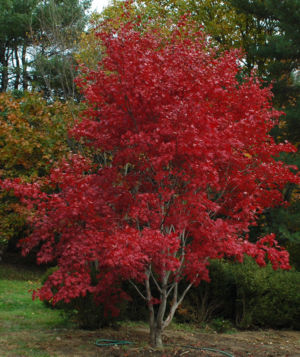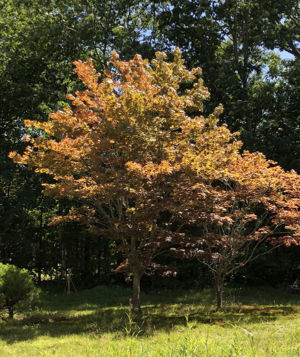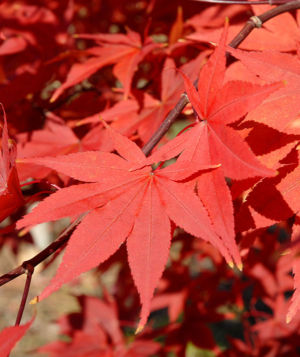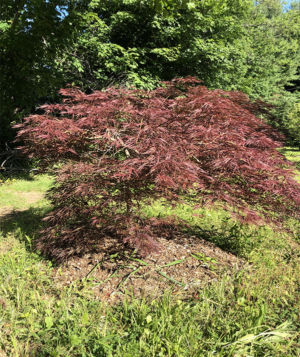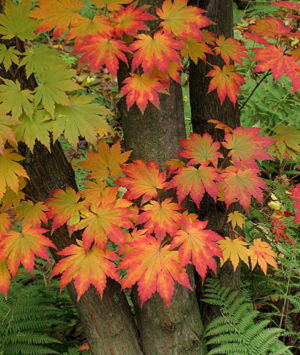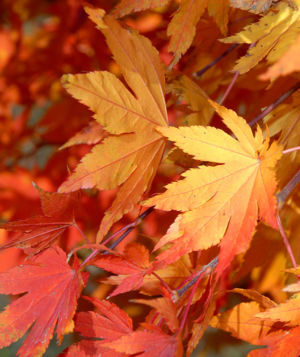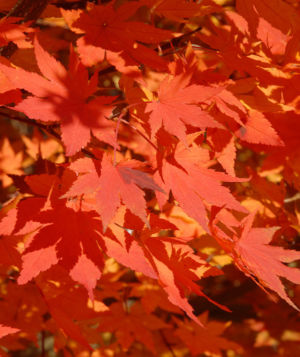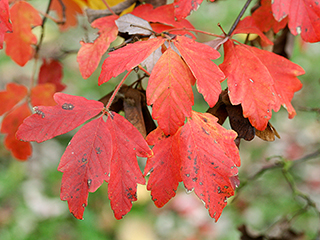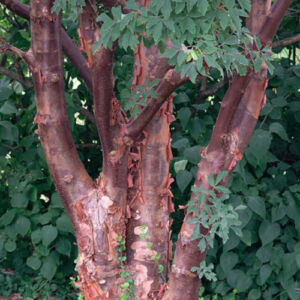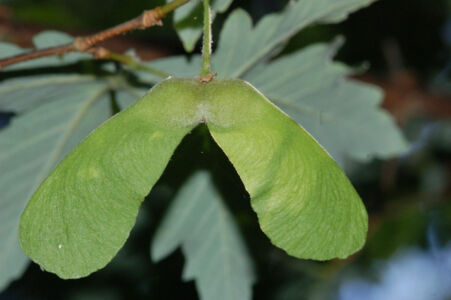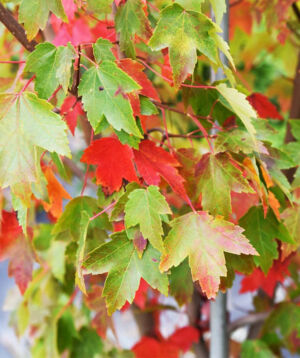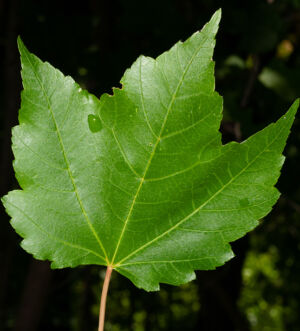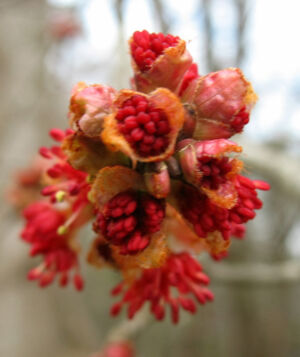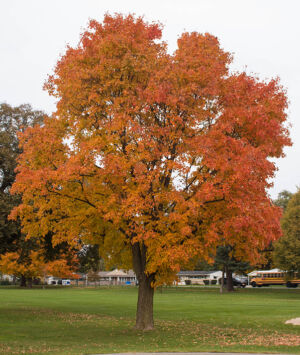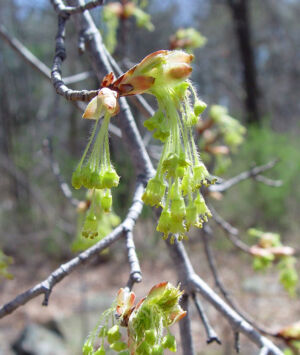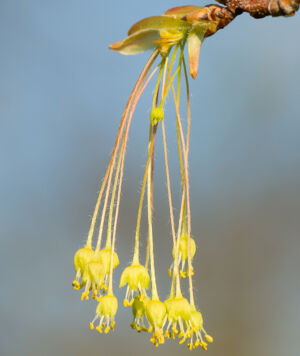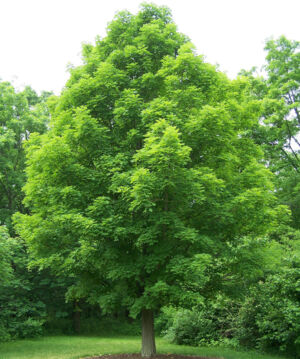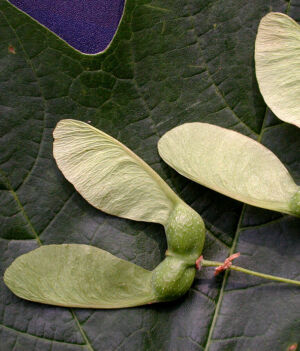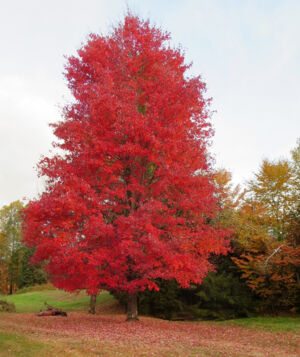Japanese Maple – Acer palmatum
Description
General: Acer palmatum, commonly known as Japanese maple, is a deciduous shrub or small tree that typically grows to 10-25′ (possibly up to 40′) tall. Native to Japan, Korea and China, has a rounded to broad-rounded form, often with low branching.
Leaves: Palmate leaves in a variety of colors, greens, reds, deep red-purple (2-5″ long) has 5 or 7 but less frequently 9 pointed toothed lobes.
Samaras: (to 3/4″ long) in pairs. Samaras ripen September-October.
Flowers: Small reddish-purple flowers in umbels bloom in mid spring (April). The flowers are very beautiful when viewed close up, but are not particularly showy from a distance.
Bark: Smooth and grey, horizontal ridges may develop with age where the bark begins to sag down the tree.
Attributes: In Fall colors can be very intense in shades of yellow, red-purple and bronze. As trees age, the flowing form that develops is beautiful in all seasons.
Culture
Hardiness: Zones 4- 8 generally. Most are more cold hardy than heat tolerant.
Growing Conditions: Prefers a moist, well-drained acidic soil in a location that receives late afternoon shade.
Maintenance: The amount of pruning needed will depend on the location and purpose of the plant. Late spring is a great time to prune as deadwood is still visible and any cuts to live wood will readily heal during the upcoming season. At this time you can make any shaping cuts and remove any unsightly and or crossing/rubbing branches.
Transplanting: The best time to transplant is late winter/early spring before the tree would naturally start breaking bud. If transplanting during the active growing season, make sure your dealing with a healthy specimen that is not drought stressed.
Our Experience
Experience at Great Hill
We have numerous varieties that provide a beautiful array of color in the Fall. Generally no insect or disease problems. Occasionally an early hard frost in our area will damage the remaining leaves and disrupt the normal Fall leaf color and drop.
Korean Maple – Acer pseudosieboldianum
Description
General: The Korean maple is a small deciduous tree that will grow to 15-25’ tall with a similar and even sometimes wider spread. It is native to Korea and parts of China.
Leaves: Medium to dark green leaves (to 5” long) with 9-11 doubly serrate lobes. Fall color is excellent with shades of intense yellow, orange and red in fall.
Fruits: Samaras that measure up to 1″ in length.
Flowers: Purple in color, in corymbs in the spring.
Bark: Grey, smooth typical to that of Japanese Maples.
Attributes: Can prove to be more cold hardy than the Japanese Maples, the form and color of this maple are beautiful.
Culture
Hardiness: Zones 4- 8.
Growing Conditions: Best in moist, organically rich, well-drained soils in full sun to part shade.
Maintenance: Depending on the site it is located, little pruning is needed, as the tree has a well rounded structure as it matures. Some corrective pruning for proper branch structure when the tree is young can be beneficial to avoid issues in the future. Pruning out of crossing branches is a good practice.
Transplanting: Spring before new foliage emerges is optimal but can be dug in the fall after the stress of summer is over. Try to avoid this when in new or soft growth.
Our Experience
Experience at Great Hill
No problems to speak of. We have several very large specimens that do quite well here.
Paperbark Maple – Acer griseum
Description
General: An upright oval to rounded tree 20-30’ in height with a spread that’s half of or equal to height.
Leaves: Opposite and trifoliate with three coarsely toothed leaflets 3-6” long. Flat dark to blueish green in the summer changing to bronze, russet red or red in the fall.
Flowers: Solitary greenish yellow 1” peduncles that appear with unfurling leaves.
Fruit: A samara 1 ½” long in the fall persisting into winter.
Bark: Exfoliating copper orange to cinnamon reddish brown bark that peels into large curls and remains on the tree. Unlike other trees with exfoliating bark, griseums display this attribute at a very young age, adding to the appeal of the tree.
Attributes: A first class small specimen tree best used where its ornamental qualities are visible.
Culture
Hardiness: Zones 5-8.
Growing Conditions: Prefers well drained moist soils and full sun. Is PH adaptable.
Maintenance: No serious insect or disease issues. Does not require pruning.
Transplanting: Transplants easily balled and burlapped or container grown.
Our Experience
Experience at Great Hill
We feature paperbark maple as THE specimen tree, front and center at Great Hill. It’s a tree that is truly worth the hype. Its exfoliating bark and handsome habit give it interest through each season and its unique trifoliate leaf along with fall leaf color are added bonuses.
Red Maple – Acer rubrum
Description
General: Pyramidal when young, red maples grow to be rounded in shape and 40 to 60′ with a similar spread. Wild trees can reach 100′ or more.
Leaves: Opposite and simple 2 to 4″ with 3 to 5 triangular, toothed lobes. Leaves emerge a reddish color maturing to green and changing in the fall to a varying mix of yellows, reds and/or oranges.
Flowers: Dense clusters of red (sometimes yellowish) flowers appear March to April before the leaves
Fruit: A reddish brown samara 2 to 3” long maturing in the early summer.
Bark: Soft gray to gray brown in color and scaly or furrowed.
Attributes: A specimen tree for lawns, parks or streets.
Culture
Hardiness: Zones 3-9.
Growing Conditions: Prefers well drained average to moist soils in full sun to part shade.
Maintenance: Leaf hopper, borer, scale, verticillium wilt and canker are some of the more serious insect and disease issues
Transplanting: Transplants easily balled and burlapped or container grown, especially when dormant.
Our Experience
Experience at Great Hill
Red maples grow wild all over Great Hill and in the surrounding nursery fields. Its a wonderful specimen tree due to its fast growth, incredible fall color and tolerance to a variety of soils and conditions.
Sugar Maple – Acer saccharum
Description
General: A native, dense and rounded maple growing 40 to 80′.
Leaves: Opposite and simple 3 to 6″ with 3 to 5 lobes. Leaves are medium green in color and change to red yellow and orange shades in the fall.
Flowers: Drooping greenish yellow clusters 1 to 3″ long on branch tips just before leaves emerge in April.
Fruit: A horseshoe shaped two winged samara maturing early in the fall.
Bark: Gray brown. Smooth in youth becoming ridged, furrowed and scaly with age
Attributes: A spectacular shade, lawn and park specimen tree.
Culture
Hardiness: Zones 4-8
Growing Conditions: Prefers well drained average soils in full sun to part shade.
Maintenance: Leaf scorch, verticilium wilt, cankers, aphids, borer, scale, and leaf spot.
Transplanting: Transplants easily balled and burlapped or container grown, especially when dormant.
Our Experience
Experience at Great Hill
We have several sugar maple cultivars on Great Hill as well as several growing wildly, that are unbeaten as specimen trees for fall color in the landscape. Sugar maple is a native used for maple syrup production as well as premium hardwood production.

